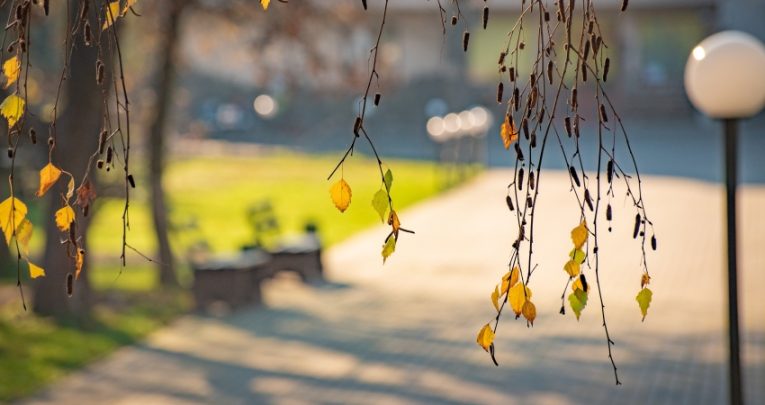Outdoor learning – What schools can do with the facilities they already have

Rebecca Leek explores what schools can do to lend an outdoor dimension to students’ learning without the need for any costly procurement or site redevelopment

- by Rebecca Leek

I should start with a disclaimer – I’m an outdoors person. If I don’t spend at least some time outside on a daily basis, I start to feel very unhappy indeed.
A highlight for me last year was trekking the Cuillin Ridge, home to some of the most precarious Munros in Scotland. I go running outdoors, rain or shine, I live off-grid most of the time in a field on the Essex-Suffolk border and I know my pears from my permains.
However, I only really worked this out later in life. When I was at school, I was one of those academic types who could rattle off an essay with relative ease, understand the difference between a minor third and augmented second, and learn the principle parts of a Latin verb without getting my passive participles in a mess.
When asked about my career ambitions, GCSE options and A Level choices, there wasn’t a whisper of the outdoors. It was going to be university – English, classics or history perhaps? Aside from PE lessons, the only time I can remember doing any outdoor learning in KS3 or 4 was the odd lunchtime before a GCSE exam, when I’d ensconce myself under a tree to read over my revision notes. That and trips, which always seemed to involve a bit of walking.
Bound by walls
Not that I have any cause to complain. The education system I was part of ostensibly suited me – a clutch of A grades, and I was on my way – but I do have some regrets. I now look at horticulture and botany courses with longing, and wonder at what may have been if I’d discovered long distance running (proper long distance running – not our painful annual cross country) earlier on.
My secondary school experience was one very much bound by walls and ceilings. What if I’d spent more meaningful time outside, or had my eyes fully opened to outdoor industries such as estates management, outdoor pursuits, farming or marine work?
Primary schools are generally better at all this. The best Early Years theorists (Froebel, Montessori, Bruce) are all very clear that the outdoors and nature are essential ingredients in a child’s education, but why does this peter out as our children get older? Is it because children can sit at desks for longer periods of time?
One needn’t look far to find research showing the benefits of being outside. The Mental Health Foundation reports that people with ‘Good nature connectedness tend to be happier’. During lockdown, many people found that being in the outdoors was essential for maintaining their equilibrium. People also reported developing new outdoor interests, such as gardening or cycling. Some even changed their careers entirely, realising that sitting in front of computer screens and long commutes simply weren’t for them.
A taste of the outdoors
As we continue to witness the steady destruction of biodiversity on our one and only planet, it’s more essential than ever to ensure that the next generation are comfortable with, and connected to nature and the outdoors. Mud and rain might not be for everyone, but rather than ignore it completely in how you deliver your curriculum and design your careers information, is it not time to give it more of a place?
There are many young people without access to gardens, whose parents don’t take them on walks or visits to gardens and forests. Even if they’re not necessarily all going to be ‘outdoorsy’ types, we at least owe those who might be a taste of the outdoors.
1. Get industrious
Consider the ‘diet’ presented as part of your careers offering. Are students made aware of the opportunities that outdoor industries provide? From the obvious (horticulture, construction) to the less obvious (dry stone wall maintenance, orchard-tree grafting), make sure people who actually work outdoors speak to your students. Is the outdoors represented in your work experience offering?
2. Appraise your grounds
What do your school grounds look like? Are they welcoming and inspiring? Some schools will be limited by their location, with very small footprints in built-up urban areas, but I’d wager that there’s always a corner that can be improved with flowers, art, seating and other additions. You might not have much direct control over the grounds in your school, but can you raise the matter with a senior leader or a governor? Any school amounts to the sum of its parts, and the levels of care a school takes over its outdoor spaces is important.
Trending
3. Review your subject curriculum
Primary schools are good at identifying opportunities for outdoor learning, even if it’s just for a short project or discrete topic. The organisation Learning Through Landscapes is a good starting point for gaining insight into how primaries approach this – see this page at the Learning Through Landscapes website for some ideas. Could you work with your HoD in identifying modules that can be taken outside? This might provide the tiny taster someone needs to discover their affinity for spaces without walls and ceilings. Who knows – there may be an aspiring mountain guide in your midst…
4. Hold al fresco events
Every secondary school I know of organises open days of one sort or another. I once worked at a secondary that really went to town utilising its outdoor spaces, so that prospective families got a taste of what the school had to offer everywhere they went. This included musicians playing in a courtyard, sculpture demonstrations, food technology displays (tasty treats under a gazebo) and live science experiments.
If time constraints are such that you can’t take lessons outside, then at the very least see how you fare with holding events outdoors. If nothing else, you’ll be giving students plenty of insight into the project management side of things.
5. Take classes outside
If you’re a form teacher, or have a pastoral role such as a head of year, what chances are there to take your group outside? Many schools schedule ‘bonding’ days into their first terms, so consider weaving outdoor experiences into these.
You have a limited amount of time to get to know the many students in your care, but I’ve found that some of the best conversations I’ve had with students have been on long walks. Could you potentially organise an outdoor registration session once a fortnight?
6. Form an eco committee
Finally, what environmental work are you doing with your students, and what profile do these activities have throughout the school? Having managed school and trust budgets, I know how significant waste management costs can be. If your school doesn’t yet have an eco committee, form one and explore what they can do to help your school manage its waste – not just general litter, but also food waste, paper, recyclable plastics and defunct equipment.
Composting should be the norm, and by engaging a student group in such projects, you’ll be providing them with valuable experiences that can connect them closer to nature.
A whole new world
Returning to the aforementioned Mental Health Foundation report, connectedness to nature is linked to happiness. As the widely documented mental health crisis continues to impact upon the students in our schools, let’s get them outside.
At worst, there’s a good chance that doing so will create a lasting memory that they take with them from school. At best, you could open up a whole new world to them which leads to a career path that makes them truly happy and fulfilled.
Rebecca Leek has been a secondary and primary classroom teacher, head of department, SENCo and headteacher; she is currently the CEO of SEAMAT – a trust of three schools in South Essex










